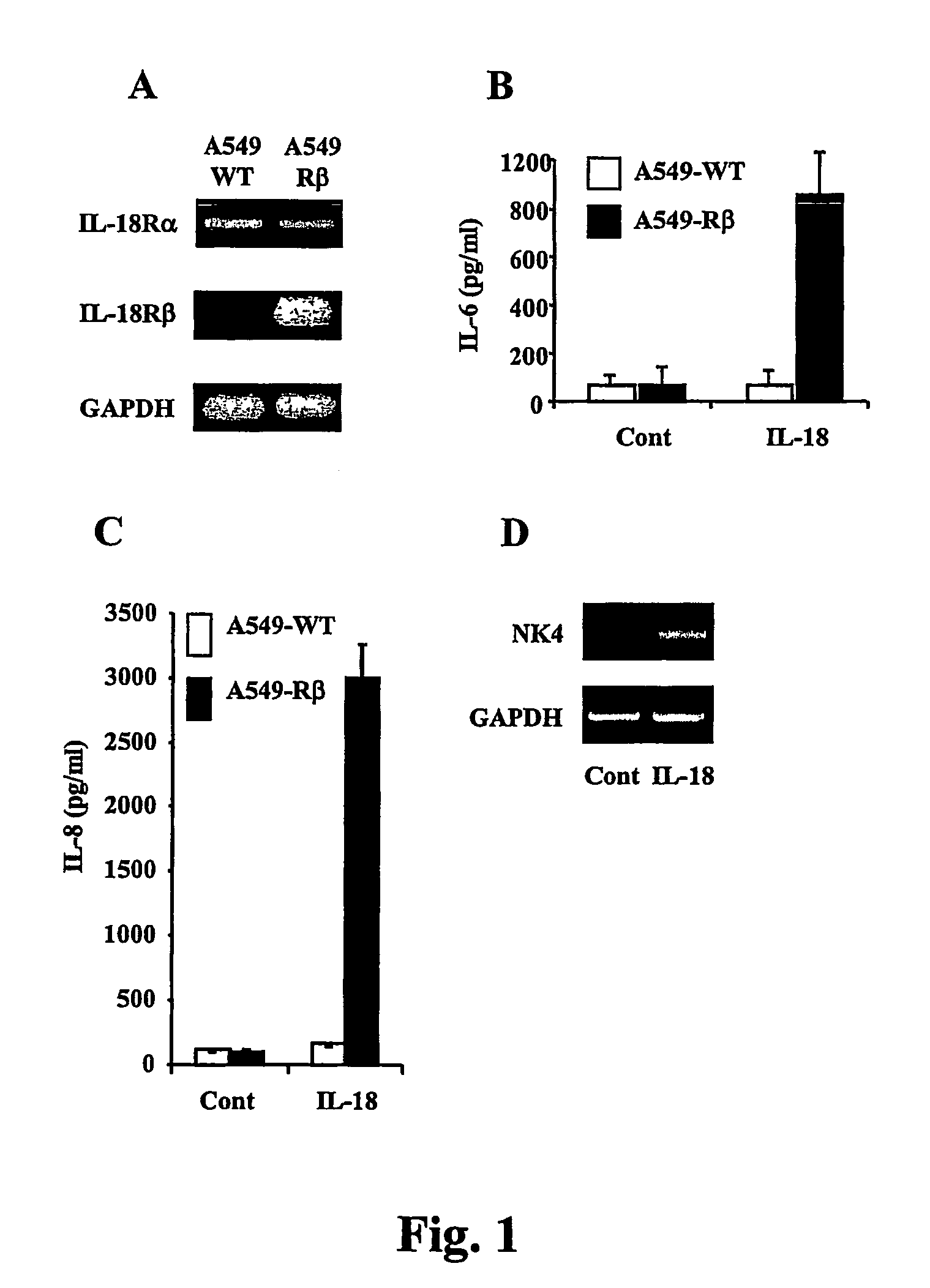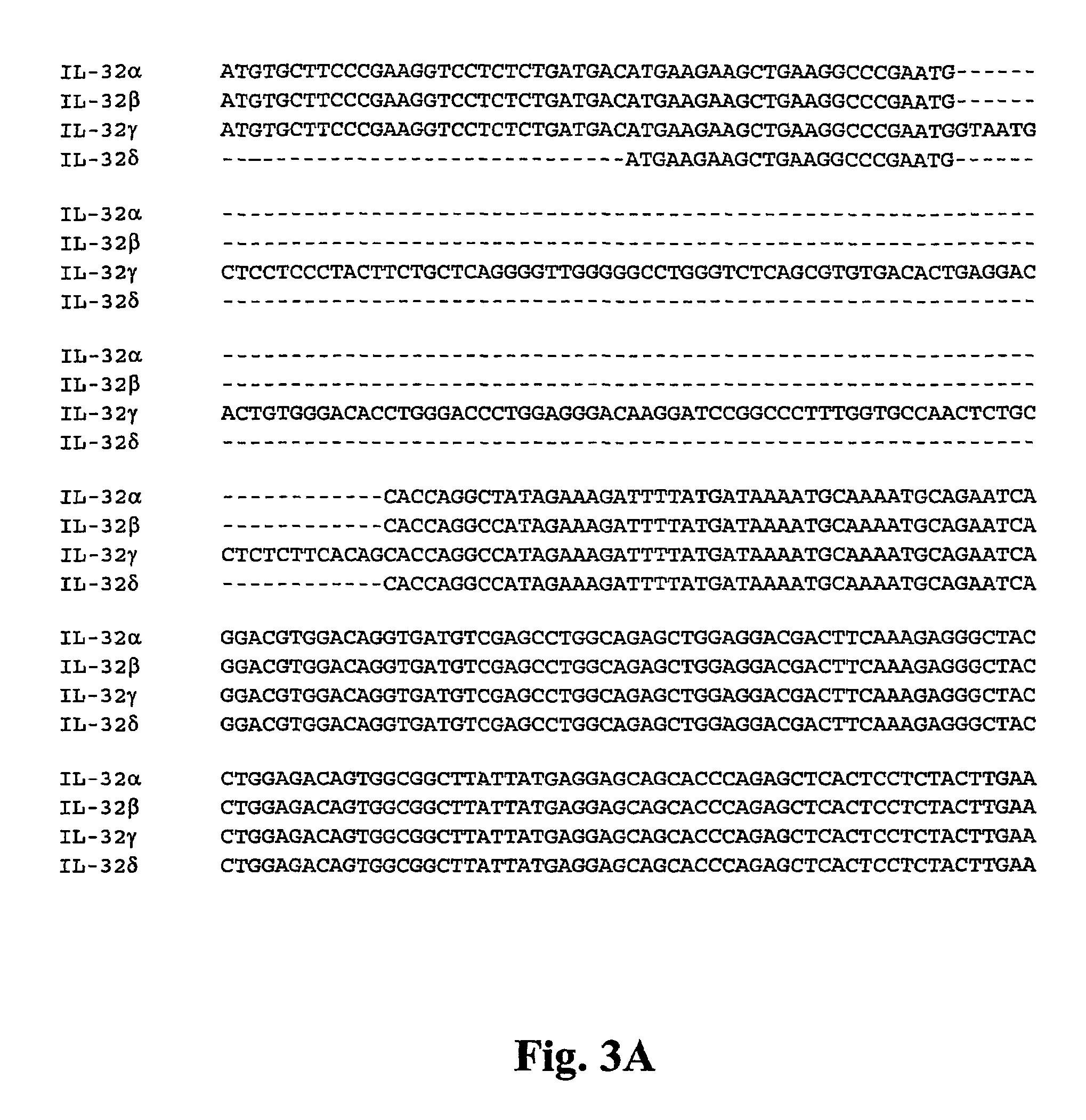Compositions for regulation of tumor necrosis factor-alpha
a tumor necrosis factor and alpha technology, applied in the direction of peptide/protein ingredients, depsipeptides, vector-based foreign material introduction, etc., can solve the problems of significant joint pain, insufficient control of methotrexate alone, and loss of mobility
- Summary
- Abstract
- Description
- Claims
- Application Information
AI Technical Summary
Benefits of technology
Problems solved by technology
Method used
Image
Examples
example 1
Identification of IL-18 Inducible Genes, including NK4 / IL32
[0136]Wild type human A549 lung carcinoma cells (A549-WT) express IL-18Rα but not IL-18Rβ. Thus, in order to express a functional IL-18 receptor in A549 cells, A549 cells were transfected with an IL-18Rβchain expression vector. Briefly, human lung carcinoma A549 cells (3×105 per well) were seeded in 6 well plates a day before transfection. The cells were then washed with 2 ml of Opti-MEM (Invitrogen, Carlsbad, Calif.) and incubated for 25 min in 1 ml of fresh medium. The transfection mixture solution for each well was prepared by mixing 5μl of Lipofectamine 2000 in 100 μl of Opti-MEM followed by a 5 min incubation in the tissue culture hood. Next, 2 μg of plasmid DNA, pTARGET / huIL-18β (Kim et al., J Immunol, 166:148-154, 2001), was added, followed by a 20 min incubation period. The transfection mixture solution was added to the wells and the plate was incubated for an additional 4 hours at 37° C. Transfection was terminated,...
example 2
TNFα Induction by Recombinant NK4 / IL-32
[0142]To determine the function of this poorly described gene product, the NK4 cDNA (See, FIG. 3, IL-32α) was cloned from NK92 cells (Dahl et al., supra, 1992, herein incorporated by reference in its entirety) into pGEMT-Easy (Promega) for sequencing, and then the insert was transferred to pPROEX / Hta (Invitrogen) for expression in E. coli or to pTARGET (Promega) for mammalian expression. Recombinant NK4 was expressed in E. coli and purified with a TALON affinity column (Invitrogen) by introducing a His6 tag at the N-terminus of the recombinant proteins. The TALON affinity-purified protein was subjected to size exclusion chromatography (Superdex 75, ÄKTAFPLC), and digested with Tobacco Etch Virus (Invitrogen) for 16 hrs at 4° C. to remove the His6 tag. The cleaved recombinant proteins were dialyzed in phosphate buffer (20 mM, pH 9). This material was later subjected to ion exchange chromatography (HiTrapQFF, ÄKTAFPLC). The recombinant NK4 protei...
example 3
Identification of IL-32 Genomic Structure and Splice Variants
[0145]The structure of the IL-32 gene and its localization within the human genome was analyzed. IL-32 was also cloned by RT-PCR from the human NK92 cell line, cultured in the presence of IL-2 (50 pg / ml), and IL-15 (200 pg / ml). The following primers were used for this purpose: sense 5′-CTGTCCCGAG TCTGGACTTT-3′ (SEQ ID NO:1), and antisense 5′-GCAAAGGTGG TGGTCAGTAT C-3′ (SEQ ID NO:2). As shown in FIGS. 3 and 5, three splice variants of IL-32 (IL-32α disclosed as SEQ ID NO:3 and GENBANK Accession No. AY495331, IL-32β disclosed as SEQ ID NO:4 and GENBANK Accession No. AY495332, and IL-326 disclosed as SEQ ID NO:5 and GENBANK Accession No. AY495333) were identified from RNA derived from NK92 cells, whereas a different splice variant (IL-32γ disclosed as SEQ ID NO:6 and GENBANK Accession No. BK004065) had been previously reported as the NK4 transcript (GENBANK Accession No: NM—004221). Thus, IL-32 is expressed as at least four v...
PUM
| Property | Measurement | Unit |
|---|---|---|
| concentration | aaaaa | aaaaa |
| concentration | aaaaa | aaaaa |
| concentration | aaaaa | aaaaa |
Abstract
Description
Claims
Application Information
 Login to View More
Login to View More - R&D
- Intellectual Property
- Life Sciences
- Materials
- Tech Scout
- Unparalleled Data Quality
- Higher Quality Content
- 60% Fewer Hallucinations
Browse by: Latest US Patents, China's latest patents, Technical Efficacy Thesaurus, Application Domain, Technology Topic, Popular Technical Reports.
© 2025 PatSnap. All rights reserved.Legal|Privacy policy|Modern Slavery Act Transparency Statement|Sitemap|About US| Contact US: help@patsnap.com



